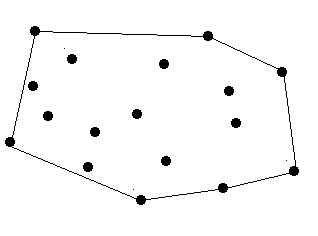Surround the Trees
Time Limit: 2000/1000 MS (Java/Others) Memory Limit: 65536/32768 K (Java/Others)Total Submission(s): 7987 Accepted Submission(s): 3044
Problem Description
There are a lot of trees in an area. A peasant wants to buy a rope to surround all these trees. So at first he must know the minimal required length of the rope. However, he does not know how to calculate it. Can you help him?
The diameter and length of the trees are omitted, which means a tree can be seen as a point. The thickness of the rope is also omitted which means a rope can be seen as a line.

There are no more than 100 trees.
The diameter and length of the trees are omitted, which means a tree can be seen as a point. The thickness of the rope is also omitted which means a rope can be seen as a line.

There are no more than 100 trees.
Input
The input contains one or more data sets. At first line of each input data set is number of trees in this data set, it is followed by series of coordinates of the trees. Each coordinate is a positive integer pair, and each integer is less than 32767. Each pair is separated by blank.
Zero at line for number of trees terminates the input for your program.
Zero at line for number of trees terminates the input for your program.
Output
The minimal length of the rope. The precision should be 10^-2.
Sample Input
9 12 7 24 9 30 5 41 9 80 7 50 87 22 9 45 1 50 7 0
Sample Output
243.06
代码:
直接套用Graham算法模板即可,注意特殊考虑输入点为1和2的情况,wa了一次。
#include <iostream>
#include <cstdio>
#include <cmath>
#include <algorithm>
using namespace std;
const double eps = 1e-8;
struct Point{
double x, y;
};
const int MAXN = 200;
Point list[MAXN];
int stack[MAXN], top;
double crossProduct(Point a, Point b){
return a.x*b.y - a.y*b.x;
}
int sgn(double x){
if(fabs(x) < eps) return 0;
if(x < 0) return -1;
else return 1;
}
Point sub(Point a, Point b){
Point p;
p.x = a.x - b.x;
p.y = a.y - b.y;
return p;
}
double dist(Point a, Point b){
return sqrt((a.x-b.x)*(a.x-b.x) + (a.y-b.y)*(a.y-b.y));
}
//相对于极点list[0]的极角排序
bool cmp(Point p1, Point p2){
double temp = crossProduct(sub(p1, list[0]), sub(p2, list[0]));
if(sgn(temp)>0) return true;
else if(sgn(temp)==0 && sgn(dist(p1, list[0])-dist(p2, list[0]))<=0) return true;
else return false;
}
/*
* 求凸包,Graham算法
* 点的编号0~n-1
* 返回凸包结果Stack[0~top-1]为凸包的编号
*/
void Graham(int n){
Point p0 = list[0];
int k = 0;
for(int i=1;i<n;i++){
if(p0.y>list[i].y || (p0.y==list[i].y && p0.x>list[i].x)){
p0 = list[i];
k = i;
}
}
swap(list[k], list[0]);
sort(list+1, list+n, cmp);
stack[0] = 0;
if(n==1){top = 1; return;}
stack[1] = 1;
if(n==2){top = 2; return;}
top = 2;
for(int i=2;i<n;i++){
while(top>1 && sgn(crossProduct(sub(list[stack[top-1]], list[stack[top-2]]), sub(list[i], list[stack[top-2]])))<=0){
top--;
}
stack[top++] = i;
}
}
int main(){
int n;
while(1){
scanf("%d", &n);
if(n == 0) break;
for(int i=0;i<n;i++){
scanf("%lf %lf", &list[i].x, &list[i].y);
}
if(n==1){
printf("0.00\n");
continue;
}
if(n==2){
printf("%.2lf\n", dist(list[0],list[1]));
continue;
}
Graham(n);
double ans = 0;
for(int i=0;i<top-1;i++)
ans += dist(list[stack[i]], list[stack[i+1]]);
ans += dist(list[stack[0]], list[stack[top-1]]);
printf("%.2lf\n", ans);
}
return 0;
}





 本文介绍了一个计算围绕指定区域内所有树木所需的最小绳长的问题。通过使用Graham算法求解凸包,进而得出最短绳长。文章提供了完整的代码实现,并对特殊情况进行了讨论。
本文介绍了一个计算围绕指定区域内所有树木所需的最小绳长的问题。通过使用Graham算法求解凸包,进而得出最短绳长。文章提供了完整的代码实现,并对特殊情况进行了讨论。
















 353
353

 被折叠的 条评论
为什么被折叠?
被折叠的 条评论
为什么被折叠?








